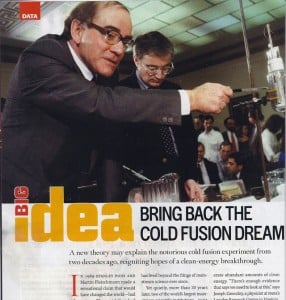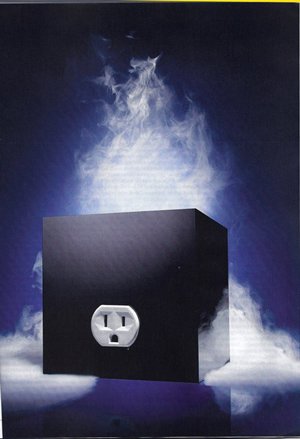A new generation is not prejudiced by authoritative decrees from a previous era.
Thus, when Andrea Rossi burst upon the digital environment 01/11/2011 with his demonstration of the Energy Catalyzer, or E-cat, a thermal energy generator powered by some as-yet-unknown nuclear process in a safe environment, without any dangerous radioactive materials, and far away from the seething core of the Sun, the planet tuned browsers and iPhones to northern Italy servers to sample the digitally-cloned experience. Public awareness has been accelerating ever since.
The new cold fusion documentary film The Believers by 137 Films won the Hugo Gold award for Best Documentary of the Chicago Film Festival, just as two science/technology magazines publish articles on cold fusion in their print versions, joining virtual versions of Forbes and Wired, among other online news and blogs, reporting on the topic.
They even went so far as advertising the fact on their covers, albeit small, and in the corner, revealing a cautious endorsement of the stories.
Popular Science Andrea Rossi’s Black Box by Steve Featherstone
Discover Magazine Big Idea: Bring Back the “Cold Fusion” Dream by Mark Anderson
Two writers were tasked with presenting the cold fusion field, also called low-energy nuclear reactions (LENR), lattice-assisted nuclear reactions (LANR), and quantum fusion, in a few pages of text with a photo or two. I can hear the Editing team now. “What’s all this chatter about cold fusion?” and “what’s up with this Rossi fellow?”
The assignment is no piece of cake. Divining the truth of this underground science and imminently about-to-change-the-world technology is as complex and mysterious as the reaction itself.
The convoluted history can only emerge into a visible figure over time, piece-by-piece. Without a theory, there is no consensus. The science itself is entrenched amidst a ground of disinformation and outright hostility from otherwise very smart people who hold positions of power and authority in science, and whose behavior betrays emotional chains to immovable preconceptions.
Applying what Marshall McLuhan noted for all new environments, one of the great discoveries in the history of humankind was kept secret by “public incredulity”. Thus, cold fusion science is categorized as cultural fiction, alongside UFOs and Atlantis.
Max Planck, one of the discoverers of quantum mechanics wrote “Science advances one funeral at a time”, and for a new generation, the idea of transforming mass into energy (by whatever means) inside a solid material at room temperature is not a startling concept.
“Like, why not?”, say the kids.
The article by Mark Anderson for Discover magazine was two full pages describing one of the more popular theories that propose to model the reaction at the nuclear level.
Developed by Lewis Larsen and Allan Widom, the Widom-Larsen Theory proposes a reaction whereby protons “capture” electrons, absorbing them, and becoming neutrons. A neutron could then interact more easily with other nucleons as it is charge neutral, and has no Coulomb force to overcome.
Dr. Joseph Zawodny is a physicist at NASA Langley Research Center in Virginia and is testing technology based on the Widom-Larsen theory, which may confirm or deny the hypothesis.
Whenever a cold fusion theory is finally confirmed by experiment, and the recipe for the reaction spelled out, the field of new energy technology will break wide open. Then, generators will be designed not as they are now, by painstaking trial-and-error, without full knowledge and control of the variables, but by intentional engineering that optimizes the system into what Peter Gluck calls LENR+.
Chief scientist at Langley Dr. Dennis Bushnell is quoted from his essay saying “LENRs could potentially satisfy the world’s energy needs at a quarter the cost of coal.”

Cold Fusion Now has long recognized the importance of vocabulary when talking to the public about nuclear reactions, and perhaps the magazine staff intuited similarly.
Scientists will eventually understand this Rumpelstiltskin reaction, and when the public finally gets a hold of it, they will name it with monikers not even dreamed of by the brightest marketing minds of today, and call it their own.
Steve Featherstone compiled a broader review of the cold fusion landscape for Popular Science.
Featherstone first sampled the community by attending the ILENRS-12 Conference held in June at William and Mary College in Virginia which attracted a number of leading figures in the field, and by visiting Italy, where he (finally) met with Andrea Rossi in his Bologna lab. He also met with other Italians skeptical of Rossi’s work, but who apparently think conventionally and know nothing of the two-decades old LENR experimental data.
Surveying conference attendees, Featherstone sums up the scientific community’s feeling of Rossi’s work by writing honestly:
“To my astonishment, after three days of asking every cold fusion researcher in the house, I couldn’t find a single person willing to call Rossi a con man. The consensus was that he had something, even if he didn’t understand why it worked or how to control it.”
They understood that Rossi is using a nickel-hydrogen type system historically known to produce large amounts of excess heat. His demonstrations have been witnessed by scientists who confirm temperature readings showing significant heat was generated.
The issue of openness, and the sharing of scientific data is another matter, and researchers will tell you fully-detailed, third-party tests and original data should be made available to the community for the sake of advancing the field. But without patent protection, those who have sacrificed decades of labor are not giving it up so easily.
But let’s forget about what’s typed as words, and look at what really communicates understanding, pictures. Popular Science gave the art department a whole page to illustrate this story.
This image they came up with reflects what people want most from this technology, electricity. Prominently featured right in the front, the century-old three-prong household plug represents the “current” need for electrical power.
The black box doubly represents the mysterious cold fusion reaction, as well as the secrecy that surrounds the object of Featherstone’s focus, Mr. Rossi’s generator, and the secrecy that blankets a sector where the Patent Office refuses to give scientists the attention demanded of a paradigm-changing energy technology.

The black box floats in the sky, like “pie in the sky”, and thus trepidation adds to the uncertainty. Like Wile E. Coyote spinning off a cliff, the unsettling feeling that you could drop like a rock at any moment, is the “ground” upon which the steam rises.
Steam is the object of the first planned cold fusion products in the form of hot water boilers for both hot and clean water, and steam generators for heating. Like a cloud, suspended, and slowly wafting behind the black box, steam rises into the deep blue, a technology within sight, but just out of reach on the horizon.
The box has a reflection below it. You can see the reflection of the electrical plug faintly just at the bottom of the of the picture, as if the box floats above water, a religious connotation associated with the highest of spiritual beings, reflecting the idealistic possibilities for a green and peaceful technological future for humans, if only we would just accept it.

Eventually, steam generators would turn turbines to generate the electricity, enough to feed the box and more, creating an infinite coefficient of performance (COP), one measure of the energy return.
Is this configuration of symbols more happenstance than design? Was the reflection just because a box was photographed on a glass table? Knowing the talent of artists who generate image for a living, I imagine the brainstorming session that came up with this image, and how, in art, serendipity can allow unconscious choices that come together as coherent message only acknowledged after the piece is finished. For these images, the simplicity is a success.
Poet Ezra Pound called artists “the antennae of the race”, intuiting a future, from the now, but the interpretations of illustrators and artists can also provide a valuable report on the current milieu.
As more minds awaken to the possibilities of cold fusion technology, surveying the state of understanding includes not just reading the written words, but reading the images, and the actions taken, too. They have always “spoken louder than words”.
Cold Fusion Now!

Oh yeah!!
“The science itself is entrenched amidst a ground of disinformation and outright hostility from otherwise very smart people who hold positions of power and authority in science, and whose behavior betrays emotional chains to immovable preconceptions.”
Ruby McLuhan Carat
He he ha! If only using words like “environment” and “chip body” made me a McLuhan!
Pardon me for beating this quote to death but your observations and McLulan’s are converging.
“An administrator in a bureaucratic world is a man who can feel big by merging his non-entity in an abstraction. A real person in touch with real things inspires terror in him.”
Marshall McLuhan
PS
You nailed it Ruby. That’s why the people making the quantum leaps “aren’t scientist”. They’re “incompetent boobs” and “idiots”.
The problem is that our culture has become more ossified and illogical, so the result is this: “During the Republican convention in Tampa, Neil Newhouse, a Romney pollster, famously said, “We’re not going to let our campaign be dictated by fact-checkers.” In private, some of Newhouse’s Republican colleagues said that they thought he was making a mistake by throwing down the gauntlet to a group of reporters like that. In practice, his challenge was never taken up.”
I am currently listening to “Atlas Shrugged” (for the second time), and it addresses the faith vs. reason dichotomy. Unfortunately, faith creeps into science too. I am told that the rate of the quantity of information doubles each year, but the quality is very hard to define. Belief retards the mind’s ability to entertain new information in an unbiased way.
There is a big difference between muscle memory and reasoning – gorillas appear to learn techniques by watching and mirroring them, but reasoning based in thought, logic, and reality, is something different.
Specifically, I can cite a link to a paper that cold fusion (LENR) has been confirmed in hundreds of published scientific papers: http://lenr-canr.org/acrobat/RothwellJtallyofcol.pdf
Yet, I am continuously seeing people who claim LENR is a myth, or to repeat the term used in the above article “cultural fiction.”
More generally, I am constantly informing my bosses about different dysfunctional things happening. On more than one occasion I was reprimanded and the content nullified, not because there isn’t a problem, but because I am not communicating in a palatable format. I can only imagine that this occurs at all levels of US businesses.
To repeat something I’ve been saying for a while: technological progress is more a matter of psychology than science.
It bugs me that none of the magazines mention what motivated Fleischmann and Pons to carry out their first experiment. This is how Richard K. Lyon explained it in his May 15, 1989 letter to C&E News (a few weeks after F&P’s March 23, 1989 press conference):
“….From the media accounts, the Pons and Fleischmann experiment appeared to have been motivated by the speculation that since electrons in a conduction band move collectively, it is possible for a conduction-band electron to act as if it were much more massive than a free electron. Thus, if there is a dislocation in the matrix of palladium ions, a site at which occupancy by two deuterium ions is marginally possible, an electron between these two deuterium ions might, by virtue of is effectively greater mass, bring them close enough for fusion to occur.
The contradiction between the observed large heat release and the very small neutron yield may be explained by making the further assumption that catalyzed cold fusion is a different process from thermal fusion. In thermal deuterium-deuterium fusion the 4He nuclei is an extremely short-lived intermediate; the two deuterons come together with both the energy needed to overcome the coulombic barrier. This thermal energy brings with it considerable angular momentum. Since the 4He nuclei is isolated, the only ways in which it can dispose of the excess energy and angular momentum are by decomposition to 3He + n and to T + H. In catalyzed cold fusion, however, the situation is quite different. The 4He nucleus is formed without significant angular momentum or thermal energy and is not isolated in that the electron which catalyzed the fusion event is available to remove excess energy.
Thus one possible explanation for the production of heat without corresponding neutron production is that when fusion is catalyzed by conduction-band electrons in palladium the dominant reaction is to 4He, with 3He + n and T + H only minor side reactions….”
Richard K. Lyon May 15, 1989 letter to C&E News
PS
I just thought I should say that reading Mark Anderson and Steve Featherstone articles did cheer me up. It’s just that I’m an old fart who remembers March of 1989. Many things have gone down the Orwellian memory hole that younger people aren’t aware of. F&P weren’t lumbering morons who needed “brilliant” people to do their thinking for them.
PS
Pardon me and my presbyopia. It should read: “…the two deuterons come together with both the energy of the reaction and the thermal energy needed to overcome the coulombic barrier.…”
Mainstream… is this sort of a mini october surprise?
Anyways I share this as a digression honoring that which is not reason and logic… enjoy.
Hamman was a philosopher who revolted against Rationalism, Totalitarianism, and the Scientific Method… his writings fueled the early formation of Romantic Individualism.
His views help balance reason with the open mind of a child leaving room for the experience of revelation in all things… that which is the real fuel for understanding is spontaneity and rflection. Art and passion intuition and experience have a foundation of belief and all reason is built on faith which has no provable reason.
“Do either nothing or everything; the mediocre, the moderate, is repellent to me: I prefer an extreme.” – Hamann
“Think less and live more.” – Hamann
“The product of paper and printed ink, that we commonly call the book, is one of the great visible mediators between spirit and time, and, reflecting zeitgeist, lasts as long as ore and stone.” – Johann Georg Hamann
“Being, belief and reason are pure relations, which cannot be dealt with absolutely, and are not things but pure scholastic concepts, signs for understanding, not for worshipping, aids to awaken our attention, not to fetter it.” – Johann G. Hamann
“Thus the public use of reason and freedom is nothing but a dessert, a sumptuous dessert.” – Johann G. Hamann
In his “Metacritique of Pure Reason” he writes:
“The sensibility and the understanding arise as two stems of human knowledge from One common root, in such a way that through the former objects are given and through the latter thought: to what end is such a violent, unjustified, willful divorce of that which nature has joined together! Will not both stems wither and be died up through a dichotomy and rupture of their common root? Would not a single stem with two roots be an apter image of our knowledge, one root above in the air and one below in the earth? The first exposed to our sensibility whereas the latter is invisible and must be thought by the understanding, which is in greater agreement with the priority of thought and the posterity of the given or taken, as well as the favorite inversion of pure reason and its theories.”
“An angel came down and troubled the Well of Bethesda, in the five grottos of many who were sick, blind, lame, consumptive lay waiting for the waters to be stirred. So the genius must lower himself to destroy the rules, else the waters remain still; once the waters are troubled, a man must be the first to step into them, if he wants to experience the virtue and effectiveness of the rules himself.”